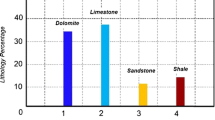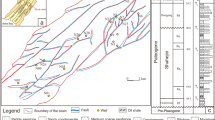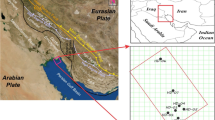Abstract
Rock physics modeling is the process of finding a relationship between seismic data and well logs. The concluded model can play a crucial role in seismic reservoir characterization studies as well as prediction of reservoir geomechanical parameters. The present study is aimed at proposing a fusion approach based on rock physics modeling to identify reservoir facies. First, we determine suitable rock physics models to predict lithology type of formation under study (the Asmari Formation) in the Mansuri oil field, south of Iran. On the basis of pore fluid type, each of the identified lithologies is divided into two classes as oil saturated facies and water saturated facies. Then we use Support Vector Machine classifier to identify desired facies. The classification is performed in two stages: single well analysis and multi-well analysis. Finally, optimistic ordered weighted averaging method is employed to fuse the results of more than one training wells.









Similar content being viewed by others
References
Adam L, Batzle M, Brevik I (2006) Gassmann’s fluid substitution and shear modulus variability in carbonates at laboratory seismic and ultrasonic frequencies. J Geophys 71:F173–F183. doi:10.1190/1.2358494
Avseth P, Mukerji T, Mavko G (2005) Quantitative seismic interpretation. Cambridge University Press, Cambridge
Avseth P, Mukerji T (2002) Seismic lithofacies classification from well logs using statistical rock physics, petrophysics. Society of Petrophysicists and Well-Log Analysts. 43, 21, 70–81
Batzle M, Wang Z (1992) Seismic properties of pore fluids. J Geophys 57:1396–1408
Blangy JP, Strandenest D, Moos D, Nur A (1992) Ultrasonic velocities in sands—revisited. J Geophys 58:344–356
Castagna JP, Batzle ML, Eastwood RL (1985) Relationships between compressional-wave and shear-wave velocities in clastic silicate rocks. J Geophys 50:571–581
Connolly P (1999) Elastic impedance. J Lead Edge 18:438–452
Cover T, Thomas J (1991) Elements of information theory. Wiley, New York
Dewar J, Pickford Sc (2001) Rock physics for the rest of US—an informal discussion. A Core Laboratory Company
Dresser Atlas (1979) Log interpretation charts. Dresser Industries Inc, Houston, 107p
Duda RO, Hart PE (1973) Pattern classification and scene analysis. Wiley, New York
Dvorkin J, Nur A (1996) Elasticity of high-porosity sandstones, Theory for two North Sea data sets. J Geophys 61:559–564
EDCO Kish International Company (2006) Unpublished Geological Studies Report for Mansuri Oil Field development in Asmari Formation
Greenberg ML, Castagna JP (1992) Shear-wave velocity estimation in porous rocks; theoretical formulation, preliminary verification and applications. J Geophys Prospect 40:195–209
Han DH, Nur A, Morgan D (1986) Effects of porosity and clay content on wave velocities in sandstones. J Geophys 51:2093–2107
Han M, Zhao G, Reynolds A (2010) Application of EM algorithms for seismic facies classification. J Comput Geosci 15:421–429. doi:10.1007/s10596-010-9212-4
Hsu CW, Lin CJ (2002) A comparison of methods for multiclass support vector machines. IEEE Trans Neu Netw 13(2):415–425
Jizba D (1991) Mechanical and acoustic properties of sandstones and shales: Unpublished Ph.D thesis, Stanford University
Karimpouli S, Hassani H, Nabi-Bidhendi M, Khoshdel H, Malehmir A (2013) Application of probabilistic facies prediction and estimation of rock physics parameters in a carbonate reservoir from Iran. J Geophys Eng 10. doi:10.1088/1742-2132/10/1/015008
Krzanowski WJ (1988) Principles of multivariate analysis: a user’s perspective. Oxford University Press, New York
Larsen AL, Ulvmoen M, Omre H, Buland A (2006) Bayesian lithology/fluid prediction and simulation on the basis of a Markov-chain prior model. J Geophys 71:R69–R78
Lipo W (2005) Support vector machines: theory and applications. Springer, Berlin
Marion D, Nur A, Yin H, Han D (1992) Compressional velocity and porosity in sand-clay mixtures. J Geophys 57:554–563
Michel G, Sergei AO, Ronald RY (1998) Fuzzy aggregation of numerical preferences. J Fuzz. set. in decis. analy. operations research and statistics. Kluwer Academic Publishers, Dordrecht, pp. 31–68
Mollajan A, Mehrgini B, Memarian H (2013a) Zonal classification by pattern recognition methods: an example from Asmari Formation (Manouri oil field, south of Iran). J Energy Explor Exploit 31(3):367–380
Mollajan A, Memarian H, Tokhmechi B (2013b) Proposing a new integral method for fluid type identification from petrophysical logs in a carbonate reservoir. J Energy Explor Exploit 31(6):895–908
Mukerji T, Gonzalez E, Mavko G, Avseth P, Takahashi I (2004) Statistical rock physics for seismic reservoir characterization, 5th conference & exposition on petroleum geophysics, Hyderabad-2004, India, pp. 567–575
Mukerji T, Jørstad A, Avseth P, Mavko G, Granli JR (2001) Mapping lithofacies and pore-fluid probabilities in a North Sea reservoir: seismic inversions and statistical rock physics. J Geophys 66:988–1001
Rimstad KJ, Avseth P, Omre H (2011) Hierarchical Bayesian lithology/fluid prediction: a North Sea case study. J Geophys 75:R1–R56, 31
Schlumberger (1998) Log interpretation principles/Application, Seven printing. March sugar Land, Texas
Serra O (1984) Fundamental of Well – logging interpretation, Elsevier, New York
Theodoridis S, Koutroumbos K (2002) Pattern classification, 2nd edn. Elsevier/Academi, San Diego
Tsuneyama F, Mavko G (2007) Elastic-impedance analysis constrained by rock-physics bounds. J Geophys Prospect 55:289–306
Ulvmoen M, Omre H (2010) Improved resolution in Bayesian lithology/fluid inversion from prestack seismic data and well observations: part 1—methodology. J Geophys 75:R21–R35
Wang Z, Nur AM (1990) Wave velocities in hydrocarbon rocks: experimental results. J Geophys 55:723–733
Yager RR (1988) On ordered weighted averaging aggregation operators in multi-criteria decision making. IEEE Trans Syst Man Cybern 18:183–190
Acknowledgments
We are deeply thankful to the Petroleum Engineering and Development Company (PEDEC) of Iran, for preparing the data for this research. We are also grateful to Dr. Negar Memarian and anonymous reviewers for their helpful suggestions that improved the paper.
Author information
Authors and Affiliations
Corresponding author
Appendix
Appendix
Solving convex optimization problem
Subject to (for any i=1, … , n)
The above constrained problem can be expressed as
Where λ i ≥0 are the Lagrange multipliers. By setting the derivatives of L with respect to w and b to zero, we have:
Substituting results from Eqs. (3) and (4) into Eq. (2) gives:
As it is obvious, the optimal λ i is the one that maximizes the function (4). It can be expressed as:
This leads to the decision function bellow:
Rights and permissions
About this article
Cite this article
Mollajan, A., Mehrgini, B. & Memarian, H. A fusion approach to identify reservoir facies based on rock physics modeling. Arab J Geosci 8, 9531–9543 (2015). https://doi.org/10.1007/s12517-015-1849-9
Received:
Accepted:
Published:
Issue Date:
DOI: https://doi.org/10.1007/s12517-015-1849-9




